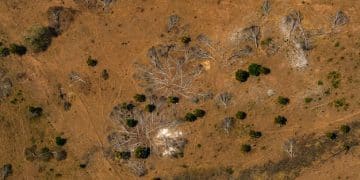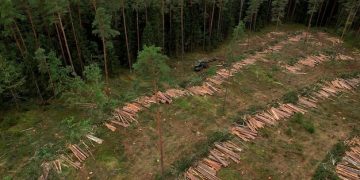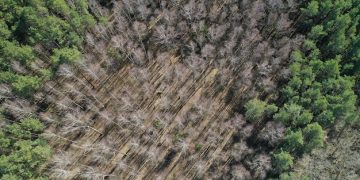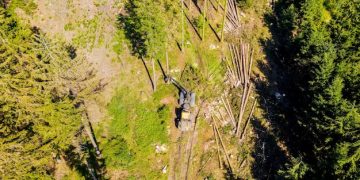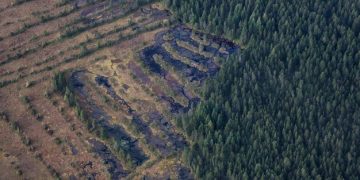Deforestation and Pollinator Decline: A US Food Security Crisis
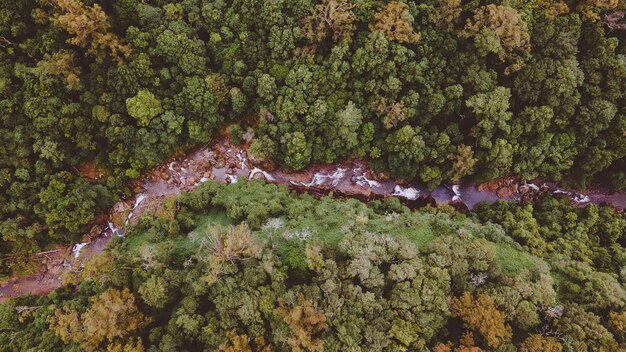
Deforestation and the decline of pollinators pose a significant threat to US food security by disrupting ecosystems, reducing crop yields, and diminishing essential pollination services vital for agriculture.
Deforestation and the decline of pollinators: A threat to US food security? It’s a question that strikes at the heart of our nation’s agricultural stability. As forests vanish, so do the vital creatures that pollinate our crops, setting off a chain reaction with potentially devastating consequences.
The Critical Role of Pollinators in US Agriculture
Pollinators are the unsung heroes of American agriculture. Bees, butterflies, birds, and other creatures tirelessly work to ensure the production of many of our favorite fruits, vegetables, and nuts. Understanding their role is the first step in grasping the severity of the threat deforestation and the decline of pollinators poses to our food security.
What are Pollinators?
Pollinators are animals that facilitate plant reproduction by transferring pollen from the male part of a flower (stamen) to the female part (pistil). This process is crucial for the fertilization of plants, leading to the production of fruits, seeds, and ultimately, new plants.
Why are They Important?
Pollinators are responsible for the reproduction of approximately one-third of the world’s food crops. In the United States, they contribute billions of dollars to the agricultural economy each year. Without pollinators, the yields of many crops would plummet, leading to food shortages and economic instability.
- Bees are the most significant pollinators, responsible for the majority of crop pollination.
- Butterflies, moths, and other insects also play a vital role in pollinating specific plants.
- Birds, such as hummingbirds, contribute to the pollination of certain flowering plants and trees.
Pollinator populations are declining due to habitat loss, pesticide use, climate change, and diseases. Each of these factors puts further strain on food production. Protecting and supporting pollinator populations is essential for maintaining a stable and secure food supply in the United States.
In summary, pollinators underpin US agriculture. Without them, the quantity and quality of our food supply would be drastically reduced. Recognizing this profound dependency underscores the urgency of addressing the factors jeopardizing their survival.
Deforestation: A Major Driver of Pollinator Decline
Deforestation poses a significant threat to pollinator populations by destroying their natural habitats and food sources. As forests are converted into agricultural lands, urban areas, and other developments, pollinators lose the resources they need to survive and thrive.
How Deforestation Impacts Pollinators
Deforestation directly reduces the availability of flowering plants, which provide nectar and pollen for pollinators. It also fragments pollinator habitats, isolating populations and reducing their ability to find mates and resources. The loss of trees also leads to soil erosion, water pollution, and other environmental problems that further harm pollinators.
The Scale of Deforestation in the US
While the rate of deforestation in the United States is lower than in some other parts of the world, it is still a significant issue. Forests are cleared for agriculture, logging, and urban development, particularly in the Southeast and Pacific Northwest. The cumulative effect of this deforestation is a substantial loss of pollinator habitat.

Here are some ways deforestation directly harms pollinators:
- Loss of nesting sites for bees and other pollinators.
- Reduced availability of nectar and pollen sources.
- Increased exposure to pesticides and other harmful chemicals.
Addressing deforestation is crucial for protecting pollinator populations and ensuring the long-term health of US ecosystems. Sustainable forestry practices, habitat restoration efforts, and policies that discourage deforestation are all essential steps in mitigating this threat.
Ultimately, understanding the connection between deforestation and pollinator decline is critical for developing effective conservation strategies. By tackling deforestation, we not only protect pollinators but also safeguard the broader environment and ensure a stable food supply for future generations.
The Economic Consequences of Pollinator Loss
The decline of pollinators has far-reaching economic consequences for US agriculture and the broader economy. As pollinator populations dwindle, crop yields decrease, leading to higher food prices and reduced profits for farmers.
Direct Economic Impacts on Agriculture
Pollinators contribute billions of dollars to the US agricultural economy each year. The decline in pollinator populations can directly reduce the production of many important crops, including fruits, vegetables, nuts, and seeds. This can lead to higher prices for consumers and reduced income for farmers.
Increased Costs for Farmers
As natural pollination declines, farmers may need to rely on more expensive alternatives, such as renting managed honeybee colonies or using hand pollination. These strategies can significantly increase production costs and reduce profitability.
Consider these economic impacts:
- Reduced crop yields lead to lower farm incomes.
- Increased reliance on artificial pollination methods drives up production costs.
- Higher food prices impact consumers, particularly low-income households.
Investing in pollinator conservation and habitat restoration can provide significant economic benefits in the long run. By protecting pollinator populations, we can ensure the stability and resilience of US agriculture.
In conclusion, the economic consequences of pollinator loss are substantial and far-reaching. Ignoring this threat could undermine the US agricultural sector and negatively impact the economy as a whole. Proactive measures to protect pollinators are essential for safeguarding our economic well-being.
The Impact on Food Security in the United States
The combined effects of deforestation and the decline of pollinators pose a serious threat to food security in the United States. Food security means ensuring that all people have access to sufficient, safe, and nutritious food to meet their dietary needs and preferences. The loss of pollinators can disrupt this critical balance.
Reduced Crop Diversity and Availability
Many of the fruits, vegetables, and nuts that are essential for a healthy diet rely on pollinators for their production. As pollinator populations decline, the availability and diversity of these crops may decrease, impacting food security.
Increased Food Prices
Decreased crop yields and increased production costs due to pollinator loss can lead to higher food prices. This can disproportionately affect low-income households, making it more difficult for them to afford nutritious food.
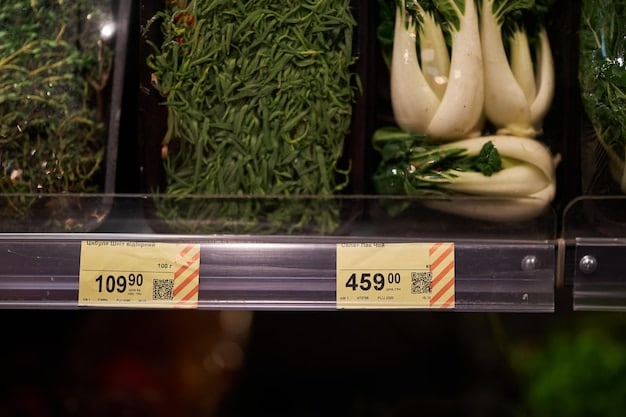
Key factors affecting food security:
- Reduced availability of pollinator-dependent crops.
- Increased food prices, making nutritious food less accessible.
- Disruption of local and regional food systems.
Protecting pollinator populations is therefore vital for ensuring food security in the United States. Conservation efforts can stabilize food supplies and ensure that everyone has access to the food they need.
In essence, the challenges posed by deforestation and the decline of pollinators are about more than just environmental concerns; they are about the very foundation of our food system. Taking action to support pollinators is an investment in the future stability of our food supply.
Strategies for Protecting Pollinators and Mitigating Food Security Risks
Addressing the threat posed by deforestation and the decline of pollinators requires a multi-faceted approach. Implementing strategies to protect pollinator habitats, reduce pesticide use, and promote sustainable agricultural practices is essential for mitigating food security risks.
Habitat Restoration and Conservation
Protecting and restoring pollinator habitats is crucial for supporting healthy pollinator populations. This can involve planting native flowering plants, creating pollinator gardens, and preserving natural areas that provide food and shelter for pollinators.
Reducing Pesticide Use
Pesticides can be harmful to pollinators, particularly bees. Reducing pesticide use and adopting integrated pest management strategies can help protect pollinator populations. Farmers can also choose to use pollinator-friendly pesticides that are less toxic to pollinators.
Here are some strategies for protecting pollinators:
- Establish pollinator-friendly habitats in agricultural landscapes.
- Promote reduced pesticide use through education and incentives.
- Support research on pollinator health and conservation.
Collaboration among farmers, policymakers, scientists, and the public is essential for implementing effective pollinator conservation strategies. By working together, we can ensure a sustainable food supply and a healthy environment for future generations.
Ultimately, integrating pollinator-friendly practices into agriculture can create a win-win scenario. Farmers can benefit from increased crop yields, while pollinators gain access to the resources they need to thrive.
The Role of Policy and Public Awareness
Government policy and public awareness are essential components of any comprehensive strategy to address deforestation and the decline of pollinators. Policy measures can provide incentives for habitat conservation, regulate pesticide use, and support research on pollinator health. Public awareness campaigns can educate citizens about the importance of pollinators and encourage them to take action to protect these vital creatures.
Policy Measures to Support Pollinators
Government policies can play a significant role in protecting pollinator populations. This can include:
- Incentives for farmers to adopt pollinator-friendly agricultural practices.
- Regulations to reduce pesticide use in agricultural and urban areas.
- Funding for research on pollinator health and conservation.
Public Awareness Campaigns
Raising public awareness about the importance of pollinators and the threats they face is crucial for fostering a sense of responsibility and encouraging action. Public awareness campaigns can educate citizens about the importance of planting pollinator gardens, avoiding pesticide use, and supporting pollinator conservation efforts.
Here are some examples of public engagement:
- Educational programs in schools and communities.
- Public service announcements on television, radio, and social media.
- Citizen science projects that involve the public in monitoring pollinator populations.
By combining effective policy measures with widespread public awareness, we can create a society that values and protects pollinators and ensures a sustainable food supply for future generations.
In conclusion, addressing the challenges requires a concerted effort from all sectors of society. The long-term well-being of our ecosystems depends on the actions we take today.
| Key Point | Brief Description |
|---|---|
| 🌳 Deforestation | Habitat loss affects pollinator populations. |
| 🐝 Pollinator Decline | Reduces crop yields and increases food prices. |
| 💰 Economic Impact | Farmers face higher costs due to reduced pollination. |
| 🛡️ Conservation | Habitat restoration and reduced pesticide use are crucial. |
Frequently Asked Questions
▼
Pollinators are essential because they help in the reproduction of many crops. Without them, the yield and variety of fruits, vegetables, and nuts would significantly decrease, impacting food availability and nutrition.
▼
Deforestation reduces the natural habitats and food sources of pollinators. Forests provide diverse flowering plants that supply nectar and pollen, which are essential for the survival and reproduction of these creatures.
▼
The economic consequences include reduced crop yields, increased food prices, and higher costs for farmers who may need to rent managed bee colonies or use manual pollination. This can destabilize the agricultural sector.
▼
Efforts include restoring pollinator habitats by planting native flowers, reducing pesticide use, and promoting sustainable farming practices. Public awareness and supportive government policies also play a crucial role.
▼
Individuals can plant pollinator-friendly gardens with native flowers, avoid using pesticides, support local farmers who practice sustainable agriculture, and educate others about the importance of protecting pollinators.
Conclusion
The entwined challenges of deforestation and the decline of pollinators represent a looming threat to US food security. Addressing this crisis demands a comprehensive approach that includes habitat restoration, reduced pesticide use, supportive policies, and increased public awareness. By working together, we can safeguard pollinator populations and ensure a stable and sustainable food supply for our nation.
